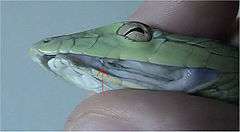Ahaetulla
| Ahaetulla | |
|---|---|
.jpg) | |
| Ahaetulla prasina | |
| Scientific classification | |
| Kingdom: | Animalia |
| Phylum: | Chordata |
| Class: | Reptilia |
| Order: | Squamata |
| Suborder: | Serpentes |
| Family: | Colubridae |
| Subfamily: | Colubrinae Link, 1807 |
| Genus: | Ahaetulla |
Ahaetulla is a genus of colubrid snakes commonly referred to as vine snakes, or whip snakes. They are considered by some scientists to be mildly venomous and are what is commonly termed as 'rear-fanged' or more appropriately, opisthoglyphous, meaning their enlarged teeth or fangs, intended to aid in venom delivery, are located in the back of the upper jaw, instead of in the front as they are in vipers or cobras. As colubrids, Ahaetulla do not possess a true venom gland or a sophisticated venom delivery system. The Duvernoy's gland of this genus, homologous to the venom gland of true venomous snakes, produces a secretion which, though not well studied, is considered not to be medically significant to humans.
Geographic range
They are found from Sri Lanka and India to China and much of Southeast Asia, including many Pacific Islands.
Species
The taxonomy of vine snakes is not well-documented, and literature varies widely, but there are 8 commonly accepted species in the genus Ahaetulla:
- Günther's Vine Snake or Indian Bronzeback, Ahaetulla dispar (Günther, 1864)
- Speckle-headed Whipsnake, Ahaetulla fasciolata (Fischer, 1885)
- Burmese Vine Snake, Ahaetulla fronticincta (Günther, 1858)
- Malayan Green Whipsnake, Ahaetulla mycterizans (Linnaeus, 1758)
- Long-nosed Whip Snake, Ahaetulla nasuta (La Cépède, 1789)
- Western Ghats Bronzeback, Ahaetulla perroteti (Duméril & Bibron, 1854)
- Oriental Whipsnake or Asian Vine Snake, Ahaetulla prasina (Boie, 1827)
- Brown-speckled Whipsnake, Ahaetulla pulverulenta (Duméril & Bibron, 1854)

Description
All Ahaetulla species are characterized by thin, elongated bodies, with extremely long tails and a sharply triangular shaped head. They are primarily green in color, but can vary quite a bit to yellows, oranges, greys, and browns. They can have black and/or white patterning, or can be solid in color. Their eyes are almost unique in the reptile world, having keen binocular vision and keyhole shaped pupils, being similar in this aspect with twig snakes, who also have keyhole shaped pupils.
Etymology

The genus name Ahaetulla comes from the Sinhalese name ehetulla for Ahaetulla nasuta, which means 'eye plucker' or 'eye striker.[1]
Behavior
They are primarily diurnal and arboreal, living in humid rainforests. Their diet consists mainly of lizards, but sometimes frogs and rodents are also consumed. Ahaetulla fronticincta, however, feeds exclusively on fish, striking its prey from branches overhanging water. Ahaetulla venom is not considered to be dangerous to humans, but serves to cause paralysis in their fast moving prey choices. They are ovoviviparous.

In captivity
Ahaetulla species are not yet frequently captive bred, as are many of the more popular snakes in the reptile keeping hobby. They are suitable for more advanced keepers, requiring a humid arboreal habitat and a diet of lizards as they rarely switch to rodents. Without proper husbandry, they are prone to health issues and stress.
References
- ↑ Wall, Frank (1921). Ophidia Taprobanica or the Snakes of Ceylon. Ceylon: Government Press. p. 291.
External links
| Wikimedia Commons has media related to Ahaetulla. |
- Genus Ahaetulla at The Reptile Database
- Ecology Asia, Snakes of Southeast Asia: Oriental Whip Snake
- Dr. Zoltan Takacs' Homebase